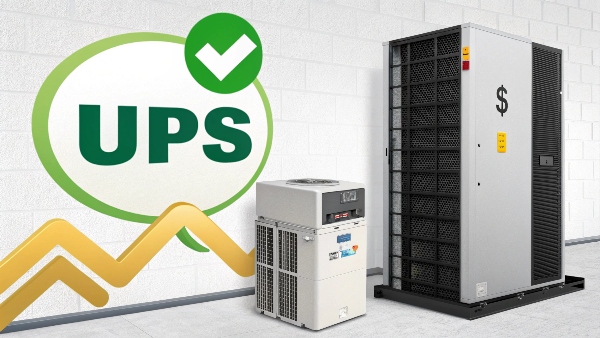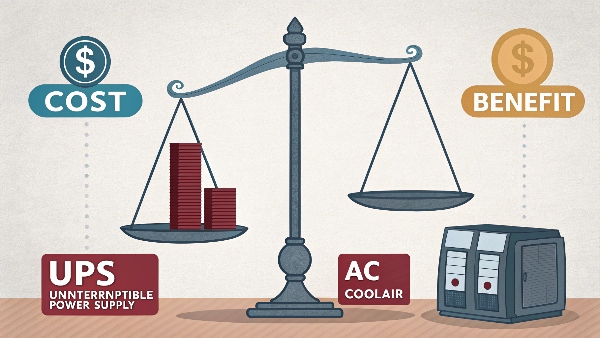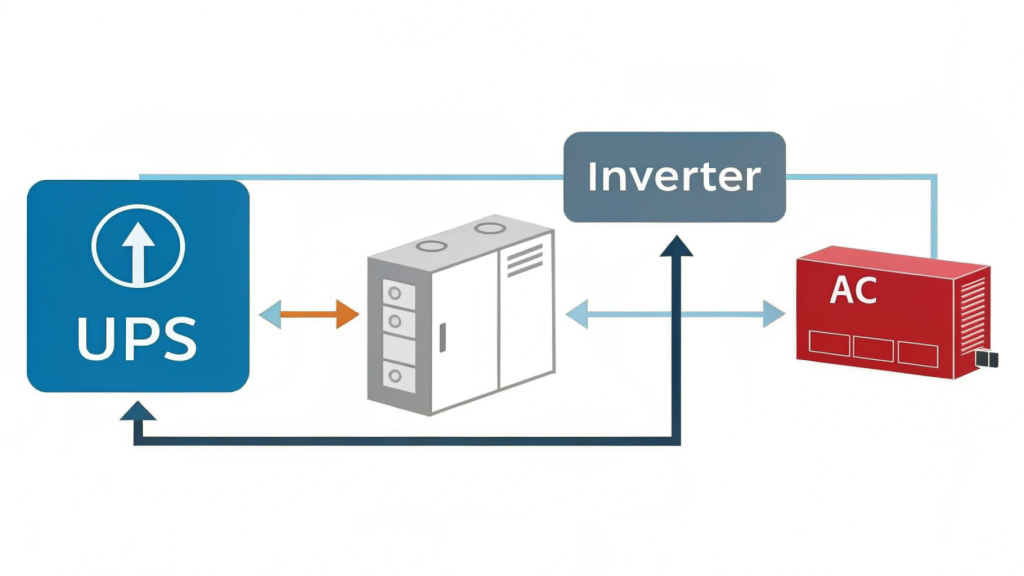Losing AC during a power cut is miserable. You wonder if a UPS, typically for computers, could actually run your air conditioner and keep you cool.
Yes, a UPS can power an air conditioner, but it requires a very large, specialized, and costly UPS. The AC's high power demand, especially at startup, makes it impractical for most standard units.

At DAOPULSE, we've been designing and manufacturing uninterruptible power supplies for a decade. We get many questions about powering various devices. My core insight is that uninterruptible power supplies can power air conditioners, printers, copiers, plotters, and other half-wave loads as well as inductive loads. However, just because it's technically possible doesn't always mean it's the most practical or cost-effective solution, especially for something as power-hungry as an air conditioner. Let's explore this further.
Can UPS be used for air conditioners?
The summer heat is intense, and power outages are a real threat. You're thinking a UPS might be the answer to keep your air conditioner running through a blackout.
Technically, yes. A UPS can run an air conditioner if it's powerful enough to handle the AC's high startup (inrush) current and continuous running wattage. A pure sine wave output is also highly recommended.

Air conditioners are demanding appliances. They have what's called an "inductive load" due to their motors and compressors. These loads, especially motors, draw a huge surge of power when they first start up – this is known as inrush current or Locked Rotor Amps (LRA). This startup surge can be many times higher than the AC's normal running wattage.
To use a UPS for an AC, you need to consider:
- Capacity (VA/Watts): The UPS must have a Kilowatt (kW) or Kilo-volt-ampere (kVA) rating high enough to support both the startup surge and the continuous running load of your AC. For example, a small window AC might need 1-2kW to run, but could surge to 5-7kW for a split second at startup. A small desktop UPS (e.g., 500VA-1500VA) won't even come close. You'd likely need a UPS in the 5kVA to 10kVA range or even larger for a typical home AC.
- Output Waveform: Motors run best and most efficiently on a pure sine wave AC output. Cheaper UPS units often output a simulated or stepped sine wave, which can cause motors to run hotter, less efficiently, or even damage them over time.
- Battery Runtime: Even with a correctly sized UPS, the battery bank required to run an AC for any significant length of time (e.g., an hour or more) would be very large and expensive.
My insight is that uninterruptible power supplies can power air conditioners... and other inductive loads, but it's a specialized application. At DAOPULSE, we can design such systems for critical needs, but for typical home use, the cost and size are often prohibitive compared to other solutions like generators.
Are UPS backups worth it?
UPS systems can be a significant investment. You're wondering if the cost is justified, especially when considering backing up something as demanding as an air conditioner.
For critical electronics like PCs and servers, yes, a UPS is definitely worth it. For an air conditioner, it's generally not worth the high cost unless continuous cooling is absolutely mission-critical.

The "worth" of a UPS depends heavily on what you're protecting and the consequences of power loss.
For computers, servers, networking gear, or medical equipment:
- Prevents Data Loss: Allows graceful shutdown.
- Maintains Uptime: Keeps critical systems online during brief outages.
- Protects Hardware: Shields against damaging surges and poor power quality.
In these cases, the cost of a standard UPS is easily justified by preventing lost work, corrupted data, or damaged hardware.
| For an air conditioner, the calculation is different: | Aspect | Pro (Worth It) | Con (Not Worth It) |
|---|---|---|---|
| Comfort | Maintains cooling during outage | Alternative cooling methods might exist (fans) | |
| Health | Critical for vulnerable individuals in extreme heat | Less critical for general comfort | |
| Cost | Potentially justifiable in critical medical/server rooms | Extremely high for UPS and battery capacity needed | |
| Runtime | Can be achieved with massive battery banks | Very short runtime with reasonably sized, affordable UPS | |
| Alternatives | Only option for silent, indoor backup | Generators are often more cost-effective for high loads |
My insight, that uninterruptible power supplies can power air conditioners, applies here, but with a strong caveat about value. For most residential users, the cost of a UPS system large enough to run an AC for a meaningful period is disproportionately high. It might be worth it if you have a critical need, like a server room where overheating would cause massive damage, or for medical reasons where temperature control is vital. Otherwise, a portable generator (used safely outdoors) is often a more practical solution for AC backup during extended outages.
Is UPS a source of AC voltage?
You know a UPS has a battery. But you're not sure how it provides power to your AC devices. Does it actually generate the right kind of electricity?
Yes, a UPS is a source of AC voltage. It uses an internal component called an inverter to convert the DC power from its batteries into standard AC voltage (e.g., 120V or 230V).

An uninterruptible power supply is more than just a battery. It's a sophisticated power management device. Here's a simplified look at how it works to become a source of AC voltage:
-
Normal Operation (Mains Power ON):
- Utility AC power comes into the UPS.
- A rectifier/charger converts some of this AC power to DC power to keep the internal batteries charged.
- The incoming AC power (often after some filtering or conditioning) passes through to your connected devices.
-
Power Outage (Mains Power OFF):
- The UPS detects the loss of utility AC power.
- It instantly switches to battery power.
- The inverter takes the DC power from the batteries and converts it into AC power. This AC power is then supplied to your connected devices.
The quality of this generated AC voltage is important.
- Pure Sine Wave1: This is the ideal AC waveform, identical to good quality utility power. It's best for sensitive electronics, motors (like in air conditioners and refrigerators), and audio/video equipment.
- Simulated/Modified/Stepped Sine Wave2: This is an approximation of a pure sine wave. It's generally fine for many modern electronics with switch-mode power supplies (like computers and phone chargers), but can cause issues with motors, some sensitive audio gear, and older equipment.
My insight is that uninterruptible power supplies can power air conditioners... and other inductive loads, and for these, a pure sine wave output from the UPS inverter is crucial for optimal performance and longevity of the appliance. At DAOPULSE, we offer various UPS types, including those with pure sine wave output specifically designed for such demanding applications.
What are the disadvantages of a UPS?
UPS systems sound like a perfect solution for power problems. But you're wondering if there are any downsides or hidden issues you should be aware of before buying one.
Disadvantages include initial cost, battery lifespan (replacement needed every 3-5 years), physical size and weight, limited runtime on battery, and minor heat/noise generation.

While UPS systems offer significant benefits, they do have some disadvantages:
-
Cost:
- Initial Purchase: UPS units, especially those with higher capacity, pure sine wave output, or extended runtime batteries, can be expensive. A UPS capable of running an air conditioner would be a very significant investment.
- Battery Replacement: Batteries are a consumable component. They typically last 3-5 years (sometimes longer or shorter depending on usage and environment) and then need to be replaced. This is an ongoing operational cost.
-
Size and Weight: Higher capacity UPS units, particularly those with large battery banks for extended runtime, can be quite large and very heavy. This can be a consideration for placement.
-
Limited Runtime: Unless you invest in a very large battery system, the runtime a UPS provides is finite, especially for high-power devices like an air conditioner. For a typical PC, you might get 5-30 minutes. For an AC, this could be mere minutes without an oversized battery bank.
-
Maintenance: Beyond battery replacement, some larger systems might require occasional checks or maintenance. Proper battery disposal is also an environmental consideration.
-
Efficiency, Heat, and Noise:
- UPS systems are not 100% efficient; some energy is lost as heat during charging and inverting. This can add to the ambient temperature in a small space.
- Many UPS units have cooling fans that can generate some noise, which might be a concern in quiet environments.
My insight is that while uninterruptible power supplies can power air conditioners, printers, copiers, plotters, and other half-wave loads as well as inductive loads, selecting the right UPS for these demanding loads is critical. An undersized or incorrect type of UPS for an AC or a laser printer (which also has high inrush current) would be a disadvantage as it wouldn't perform correctly or could even be damaged. Proper sizing and feature selection (like pure sine wave) mitigate this.
Conclusion
A UPS can power an AC, but it's often impractical due to high cost and size. For most electronics, a UPS is an excellent investment for protection and backup power.

